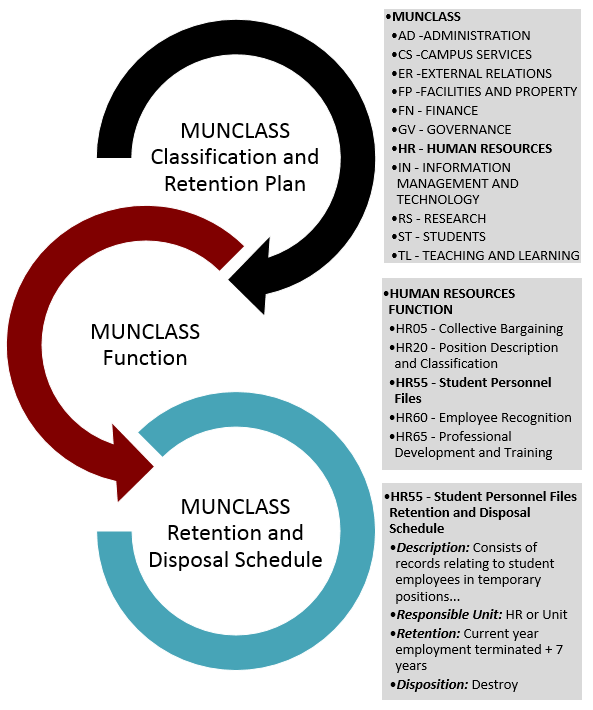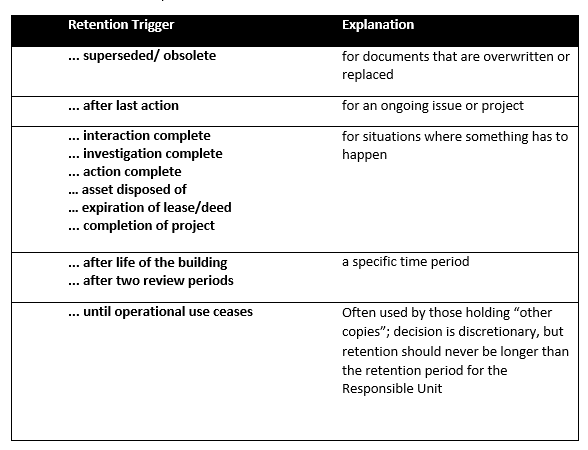User Guide
To download the pdf version of the MUNCLASS User Guide, click MUNCLASS User Guide.
The MUNCLASS Classification and Retention Plan is the primary tool through which the Information Management Policy is implemented.
MUNCLASS functions as the global view of the records generated by the university and includes a classification scheme and Retention and Disposal Schedules (RDS) corresponding to eleven functional areas. The main purpose of MUNCLASS is to:
- offer standard terminology for the identification of records series that exist across multiple units;
- provide a classification system for the naming and organization of paper and electronic records;
- establish standard retention rules for records held in university offices; and,
- outline how these records are to be disposed of.
MUNCLASS is still under development. For assistance with managing records which are not yet covered by an approved MUNCLASS RDS, contact Information Management and Protection.
Draft RDS which have not yet been finalized and approved may be posted to this website to assist units in classifying records and to make them available for review and comment. These are highlighted as ‘Draft’. Your input is invited on these draft RDS: please address any questions or comments to Information Management and Protection.
Identify the records for which you need records management guidance in MUNCLASS. In order to classify your records, it is important to understand three basic building blocks of MUNCLASS: ‘Function’, ‘Responsible Unit’ and ‘Records Class’.
Function: MUNCLASS provides a classification framework for organizing records into eleven functional areas:
-
Administration (AD)
-
Campus Services (CS)
-
External Relations (ER)
-
Facilities and Property (FP)
-
Finance (FN)
-
Governance (GV)
-
Human Resources (HR)
-
Information Management and Technology (IN)
-
Research (RS)
-
Students (ST)
-
Teaching and Learning (TL)
Responsible Unit: The Responsible Unit (RU) is the office or unit that is principally accountable for the creation and maintenance of a particular class of records. MUNCLASS names the RU for each records class. In some cases, the RU is very specific; in other cases, it is generic. For example, not all units manage 'Parking Services,' therefore, Facilities Management is designated as the RU for these records. By contrast, most units hold ‘Communications’ files, so all units are designated as the RU for such files.
Records Class: Each function is broken down into individual Records Classes which serve as the basic unit of MUNCLASS. A Record Class is a group of related records that support and document a function, activity or transaction. Each MUNCLASS Records Class has an associated RDS. The following image provides a visual illustration the organization of MUNCLASS into Functions and Records Classes (RDS).

Records should be filed according to the MUNCLASS Classification Plan and maintained until the file is closed. Records should be managed in the same way regardless of format (paper or electronic). A good starting point is to create a File Classification Plan.
File Classification Plan: reflects the records classes within your unit. It is good practice to create a listing of files that are opened and closed. The list can take any format (table, spreadsheet, etc.). The best place to start when creating a File Classification plan is to conduct a records inventory (if you have not done so already). Use our inventory worksheetto help get started. This inventory can form the basis of your File Classification Plan.
The following information should be included in your File Classification Plan:
-
File Title
-
MUNCLASS Record Class
-
Date Range
-
Status (open or closed)
-
Contents/Description
-
Location (shared drive, physical location, email, etc.)
Having a File Classification Plan for the unit will assist the unit in quickly organizing a list of files ready for disposal when it comes time to implement the MUNCLASS RDS.
Retain Records: The retention period – the amount of time Official University Records need to be kept as prescribed in – are based on federal and provincial statutes and regulations, University policy, information management best practice, and anticipated operational use.
Transitory Records are records of temporary usefulness, in any format or medium, having no ongoing value beyond an immediate and minor transaction or the preparation of a subsequent record. These records are not essential to the fulfillment of statutory obligations or the documentation of university functions and may be securely disposed of without a RDS. See our guideline For The Record: Transitory Records for more information.
Closing files: A file is closed when no more records are to be added to it. It is important to know when to close a file, since typically the retention periods prescribed in a RDS only apply once the file has been closed. When to close a file depends on its "close type." There are two main close types:
- Event-based: There is a definitive event which triggers the closure of the file because the business documented in the file is completed. i.e., a personnel file is closed when a certain event occurs such as when the employee leaves the university or a project file is closed when the project is complete.
- Time-based: There is a definitive calendar date which triggers the closure of the old file and the opening of a new file. i.e., some files may close at the end of each semester, or at the end of each fiscal year (March 31) or at the end of each calendar year (December 31).
Retention Triggers: How long a file is retained before being destroyed or transferred to the University Archives is a combination of a time period (i.e. two years, six months, etc.) and a retention trigger. The retention trigger indicates when the time period begins (or when the file can be closed). The following chart lists some examples:

Disposition Methods: There are several ways for records to be disposed of.
Selective Retention: a disposition of ‘Selective Retention’ indicates that the University has identified the records to be of potential long-term historical value to the University. Units should contact the University Archivist to notify them that records are ready for review once the retention period has expired. The Archivist will review the records and may decide to retain some or all of the records in the University Archives. Once the records have been reviewed, the Archivist will direct the unit regarding disposition.
Destroy: a disposition of ‘Destroy’ indicates that the records can be disposed of by a number of different means: deleted, recycled or securely shredded.
Destruction Form: For all records destroyed pursuant to MUNCLASS RDS, units must complete a Records Destruction Form, have it signed by a senior person within the unit, and retain it permanently for their records. The contents of completed destruction forms should not contain personal information or matters sensitive to the University.
Records that contain personal or confidential information must be destroyed in such a way that their contents cannot easily be reconstructed.
Important Note: MUNCLASS RDS must not be used as the authority to destroy any records pertaining to an ongoing or reasonably anticipated investigation, legal action or proceeding, Access to Information and Protection of Privacy (ATIPP) request, grievance audit or program review. This holds true even if the retention period or disposition date specified for the records has already expired.
RU Versus Non-RU: The retention period for the RU is very specific. For the unit that is not the RU and which may be holding ‘other copies’, the retention period is most often left to the discretion of the unit. Normally, the retention period is “Until operational use ceases”. Operational use refers to the day-to-day use of a record to facilitate the ongoing business of an office or unit. Operational use is usually not longer than three years, and is never longer than the stated retention period for the RU.
Note that under the Access to Information and Protection of Privacy Act (ATIPPA), 2015, records containing personal information that have been used to make a decision must be retained for a minimum of one year in order to permit the individual the opportunity to request access to those records. Therefore, a unit holding ‘other copies’ of such records should not dispose of them before one year.
Important Note: Records retained until operational use ceases should never be retained longer than the official copy. If units find that operational use is ongoing, please consult with the Information Management and Protection office for review of MUNCLASS.
1. Determine the records class or record series for which you need retention guidance.
If you have a large amount of records you are trying to determine the retention period for, first break down the records into categories:
-
Are the records all of one type? (i.e. invoices, timesheets, equipment catalogues)
-
Are the records filed together in a series? (i.e. employee files, student files)
2. Check ‘MUNCLASS’ to find the retention and disposition requirements.
Retention requirements are grouped together according to the record class they represent. For example:
-
if you have purchase orders, invoices, charge accounts, supporting documents, cheques and moving expenses, these all related to the ‘Finance’ function of MUNCLASS and are part of the ‘Accounts Payable’ records class.
-
if you have reason for absence forms, reporting forms for paid time off, and forms for temporarily adjusted workloads, these all relate to the ‘Human Resources’ function of MUNCLASS and are part of the ‘Work Schedules and Absences’ records class.
-
if you have media clips, briefing material, media contact lists, communications plans and speeches, these all relate to the ‘External Relations’ function of MUNCLASS and are part of the ‘Communications’ records class.
3. Once you have determined the Function and Record Class that the records relate to, check the retention rules attached to that function.
-
Reference the columns ‘Retention’ and ‘Disposition’ in the MUNCLASS plan for retention and disposal information.
-
The retention rules will indicate:
-
how long to keep records
-
when to dispose of records
-
how to dispose of records
If no retention rules are listed for the records you are looking for, contact Information Management and Protection.